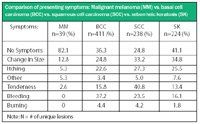- Acne
- Actinic Keratosis
- Aesthetics
- Alopecia
- Atopic Dermatitis
- Buy-and-Bill
- COVID-19
- Case-Based Roundtable
- Chronic Hand Eczema
- Chronic Spontaneous Urticaria
- Drug Watch
- Eczema
- General Dermatology
- Hidradenitis Suppurativa
- Melasma
- NP and PA
- Pediatric Dermatology
- Pigmentary Disorders
- Practice Management
- Precision Medicine and Biologics
- Prurigo Nodularis
- Psoriasis
- Psoriatic Arthritis
- Rare Disease
- Rosacea
- Skin Cancer
- Vitiligo
- Wound Care
Article
Detecting skin cancer
Early detection of melanoma in older groups, particularly men, has the potential to markedly reduce the death rate of melanoma.

Key Points

Dr. Warshaw and colleagues note that previous research has shown that the main determinant of melanoma prognosis is tumor thickness.
Prior studies also have shown that men older than 50 years present with the greatest proportion of thick tumors, and mortality is greatest in men older than 65 years of age.
The study
This analysis in which Dr. Warshaw and colleagues examined the signs and symptoms of malignant melanoma, basal cell carcinoma (BCC), squamous cell carcinoma (SCC) and seborrheic keratosis was part of a larger study on teledermatology funded by a VA Health Services Research grant, involving 3,039 skin neoplasms in 2,152 patients at the Minneapolis VA Medical Center from December 2002 to August 2005.
Patients were recruited from two main populations.
The first group included patients referred for dermatologic evaluation of a skin neoplasm by a nondermatology healthcare provider (consult).
The second group included patients seen in the general dermatology clinic who requested or required a biopsy or removal of a skin lesion.
The average age of the study participants was 72 years. Because patients were recruited from a VA medical center population, they were almost exclusively male.
At presentation and prior to any procedures, participants were asked about signs and symptoms of specific skin lesions, including itching, bleeding, change in size, tenderness, burning, no symptoms and/or other symptoms. Patients could report more than one sign or symptom.
Of the 3,039 enrolled lesions, 1,700 were biopsied. In all, 748 participants with 912 histopathologically confirmed lesions were included in the substudy: malignant melanoma (39), BCC (411), SCC (238) and seborrheic keratosis (224). Pearson chi-square analyses were used to test associations of lesion type and specific signs/symptoms in pairwise comparisons.
"First, in 82 percent of the malignant melanoma cases, patients reported no symptoms as compared with basal cell carcinoma, squamous cell carcinoma or seborrheic keratosis.
"Second, itching was reported statistically less often by patients with malignant melanoma compared with basal cell carcinoma, squamous cell carcinoma and seborrheic keratosis," Dr. Warshaw says.
Thirdly, tenderness was more commonly reported with SCC (40 percent) compared with malignant melanoma, seborrheic keratosis or BCC.
Bleeding was more commonly reported with BCC (37 percent) compared with seborrheic keratosis, squamous cell carcinoma, or malignant melanoma, she says.
Only 12.8 percent of the patients in this study reported a change in size. However, the study did not specifically ask about change in color, ulceration or change in elevation.
"Similarly, we found lower rates of all signs and symptoms in our patients with melanoma, including itching (51 percent), tenderness (2.6 percent) and bleeding (0 percent). All of the malignant melanoma lesions in this study were in men.
Several limitations were noted for the study, including the small sample size for melanoma (n=39), the fact that no nodular melanomas were in the study cohort, and the study population characteristics were relatively homogenous, which limits generalizability.
Newsletter
Like what you’re reading? Subscribe to Dermatology Times for weekly updates on therapies, innovations, and real-world practice tips.











